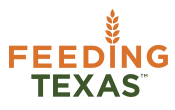Familiar, but hard to measure
Hunger is a familiar physical sensation, but can be hard to measure in a large population. Food insecurity offers an accepted method for measuring food deprivation.
The USDA defines food insecurity as a state in which “consistent access to adequate food is limited by a lack of money and other resources at times during the year.” Good shorthand terms for food insecurity are “struggling to avoid hunger,” “hungry, or at risk of hunger,” and “hungry, or faced by the threat of hunger.”
How many Texans are food insecure?
According to the latest USDA report, 14.3% of Texas households (one in seven) experienced food insecurity in the years 2014-2016. Texas was one of just fifteen states with higher food insecurity than the nation during this period. In raw numbers, 1.4 million Texas households were food insecure, more than almost any other state.
What does “food insecurity” not mean?
Food insecurity is not “the government’s definition of hunger.” It is a broader term that describes outright hunger and the coping mechanisms that households use to avoid hunger.
Food insecurity is a household situation, not an individual situation. While food insecurity affects everyone in a household, it may affect them differently. Specific individuals in a home (such as children) may be shielded from some aspects of food insecurity by caregivers.
Food insecurity is a year-long measure. It is impossible to say whether a food insecure household is “hungry right now,” “going hungry tonight” or “does not know where their next meal is coming from.” Research shows that food insecurity tends to be episodic and often cyclical.
Food insecurity does not mean that a household lacks access to grocery stores, lives in a “food desert,” or does not have time to shop/cook. It only refers to lack of food access based on financial and other resources.
Go deeper
We recommend the following resources to learn more about food insecurity:
